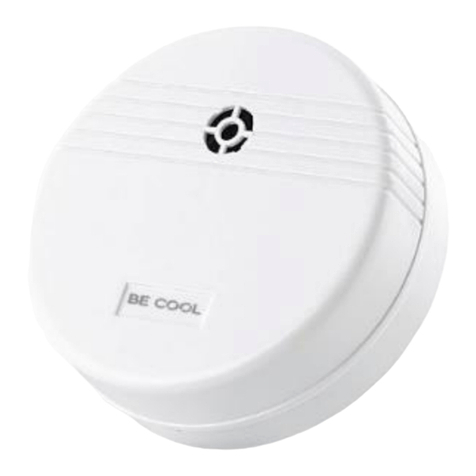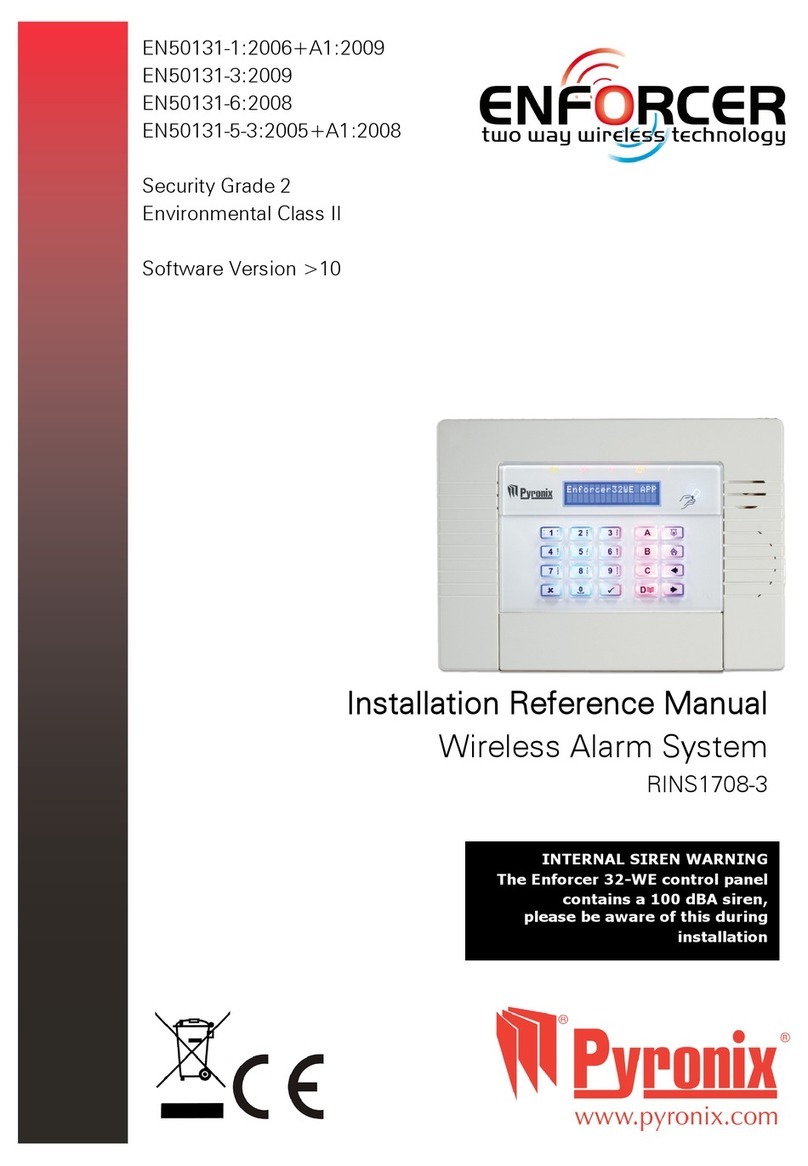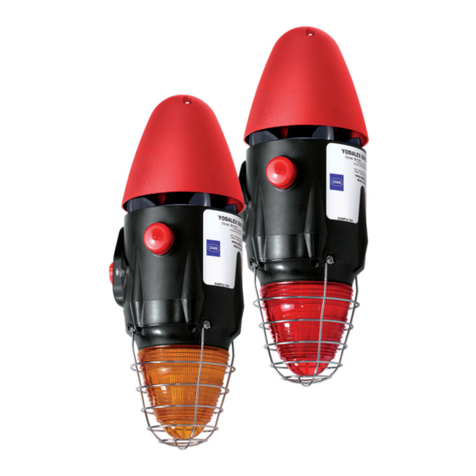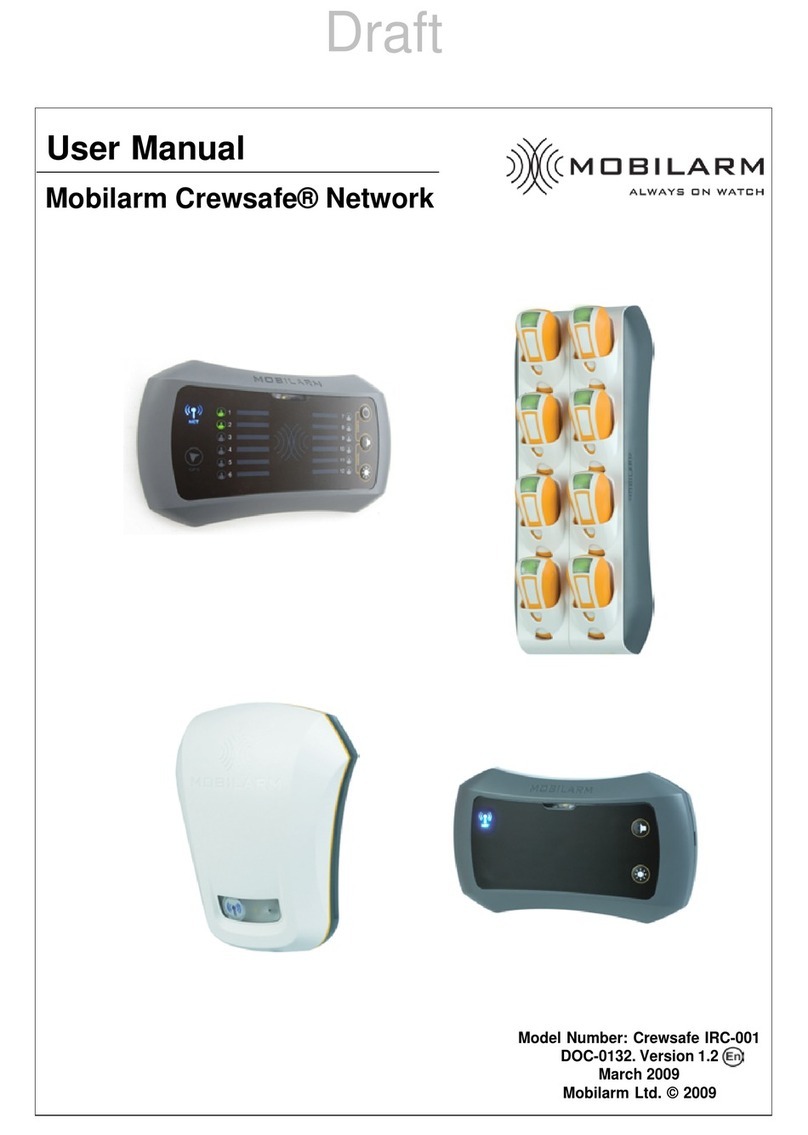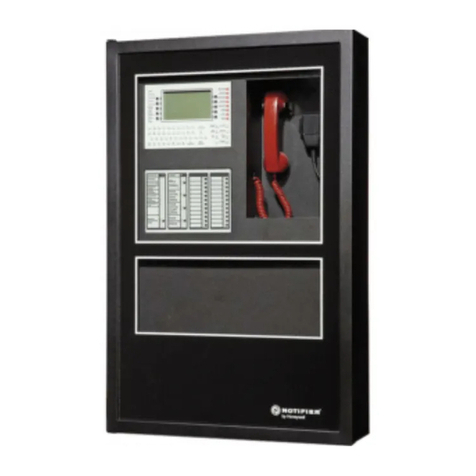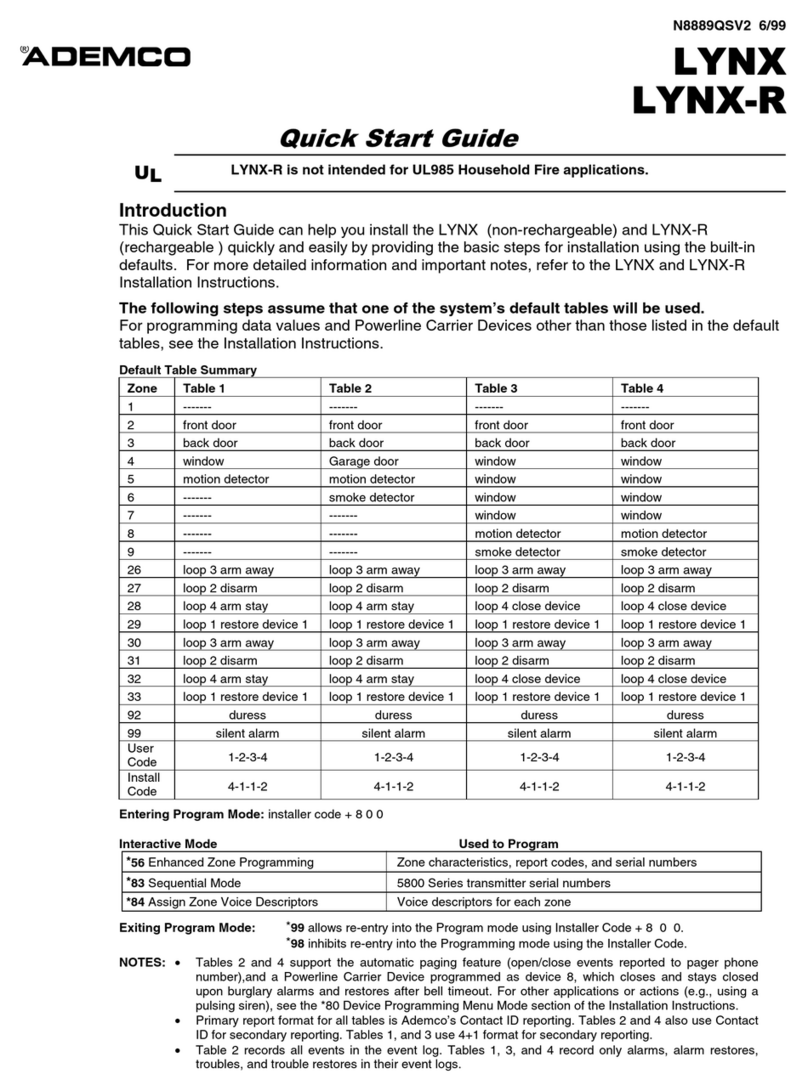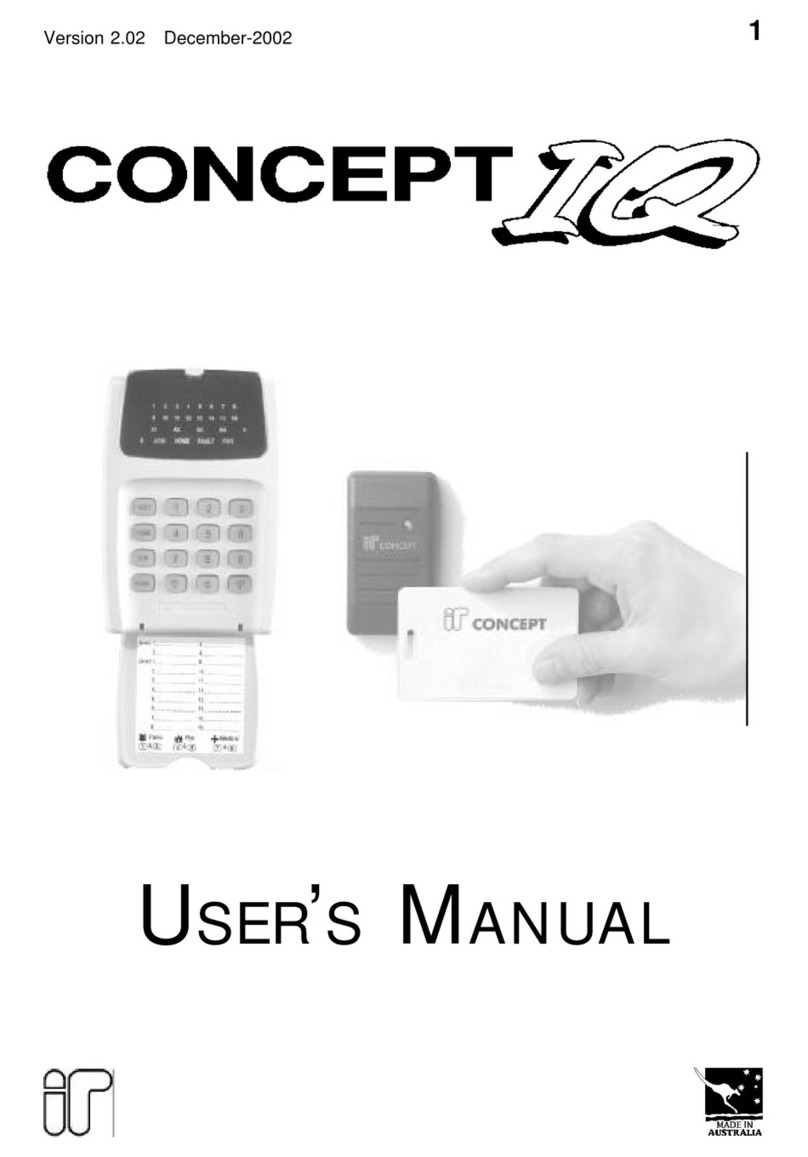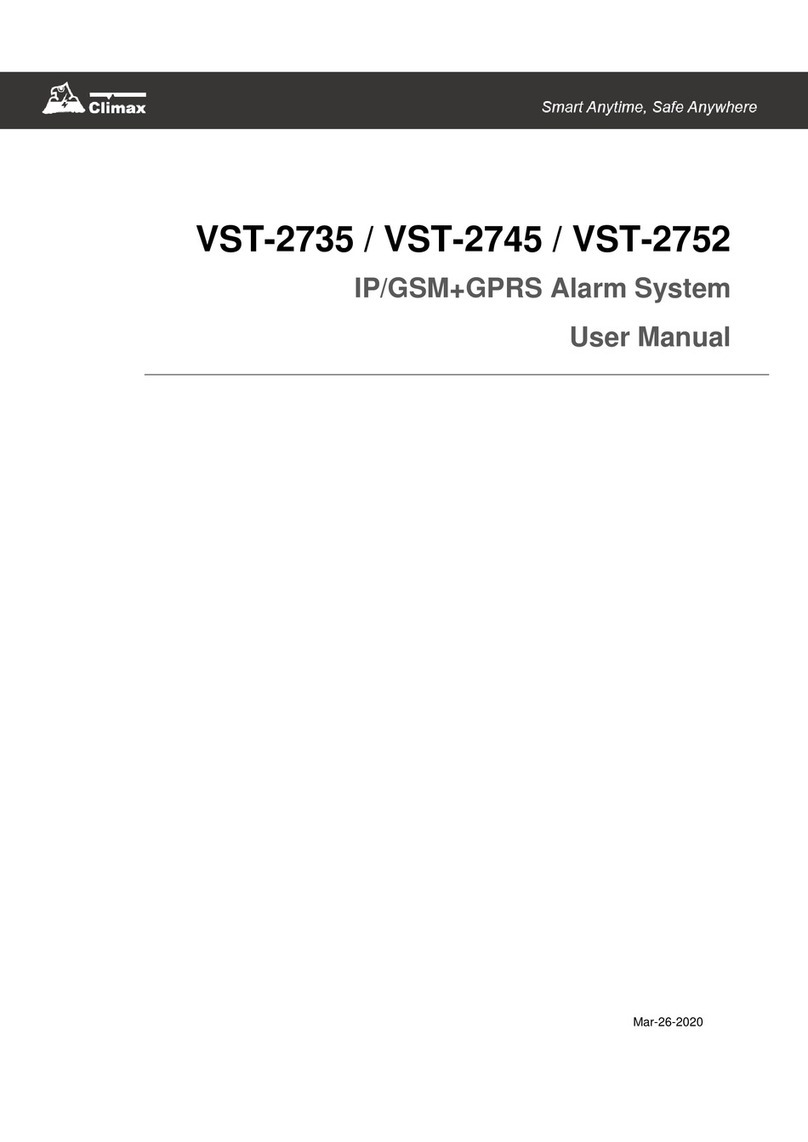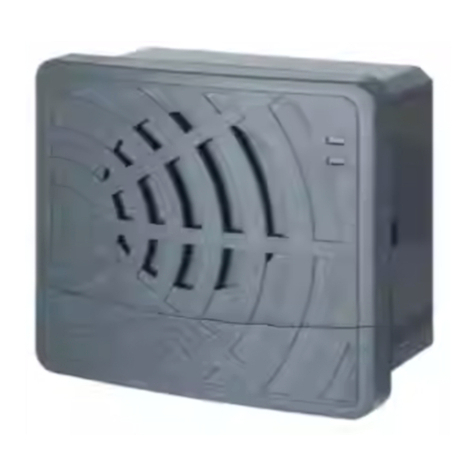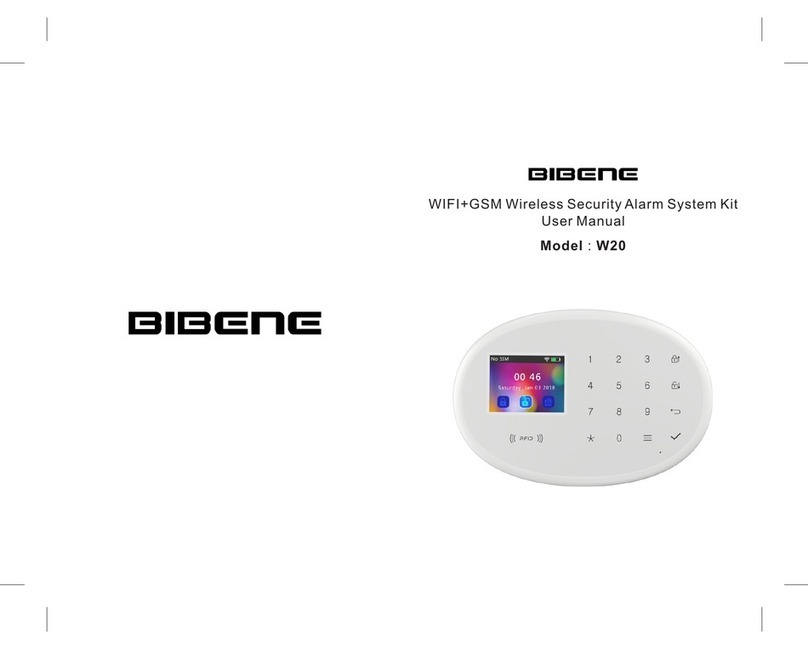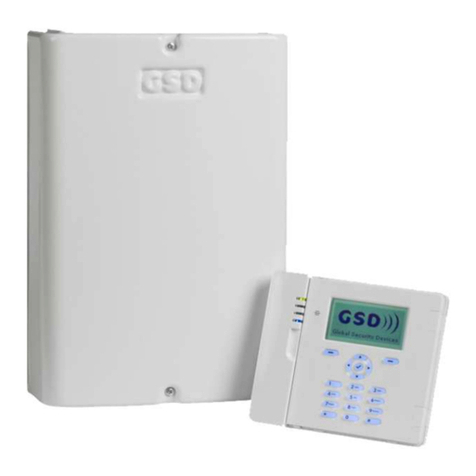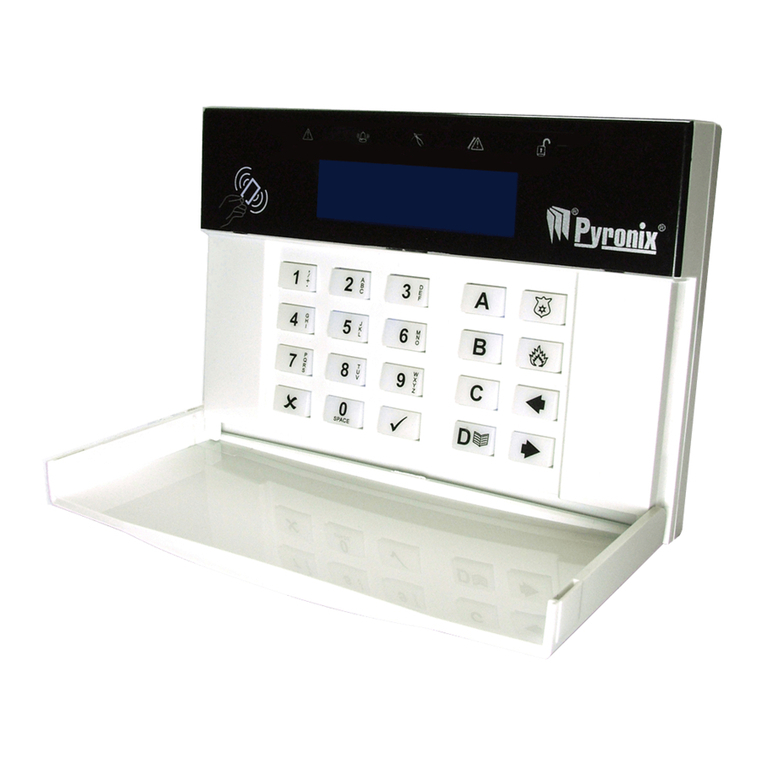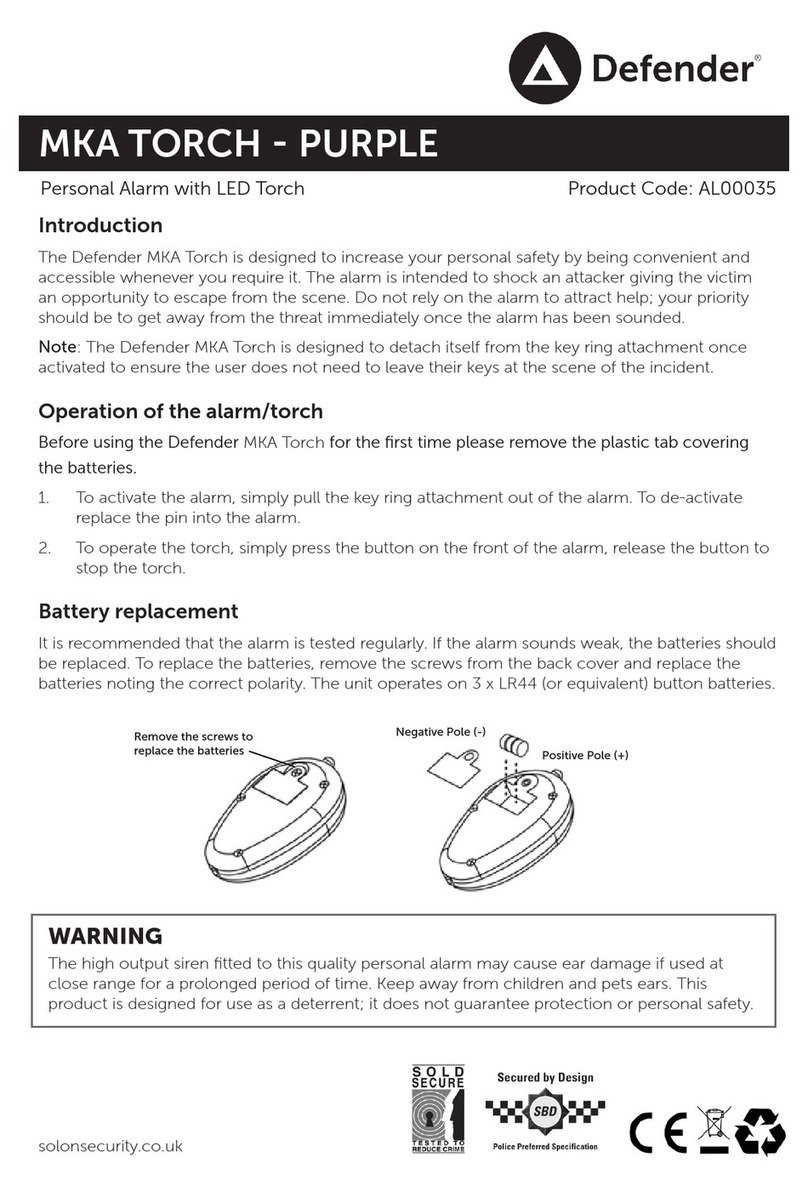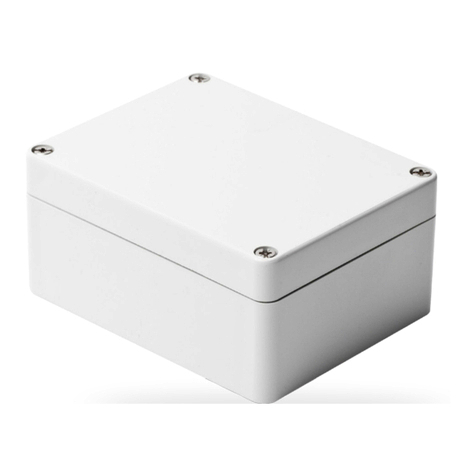Electronics VOXX AS-9234E User manual

128-9429
1 of 32
1
Model AS-9234E
Installation Manual
Vehicle Security System
With Remote Start
PATENTED: www.voxxintl.com/company/patents
Table Of Content:
Before You Begin Page 2
Wire Harness Quick View Pages 3 & 4
Mounting Of The Major Components Page 5
6 Pin Power Harness Wiring Pages 6 & 7
22 Pin Accessory I/O Harness Pages 8 - 14
2 Pin Door Lock Harness Wiring Pages 15 - 17
4 Pin Gnd, Park Light & Siren Harness Pages 14 & 15
Timed Start Programming & Operation Page 18
Optional RF Data Converter Kit Pages 6, 18, & 27
Diesel Set Up And Programming Page 19
Monitoring The Vehicle's Engine Page 19
Tach Programming Pages 19 & 29
Diagnostics Page 20
Multi Coil Pack Adapter Page 20
Testing Your Installation Pages 21 - 24
Remote Start Override Page 21
Dome Delay Learn Routine Page 25
Adjusting The Shock Sensor Page 25
Completing Your Installation Page 25
Shock Sensor Selections While Remote Starting Page 26
Programming Transmitters Page 27
Programming Alarm Feature Bank 2 Pages 27 & 28
Programming Remote Start Features Bank 3 Pages 29 & 30
Circuit Wiring Diagram Page 31

128-9429
2 of 32
2
Before You Begin
PROFESSIONAL INSTALLATION IS
STRONGLY RECOMMENDED
Roll down window to avoid locking the keys in the vehicle during installation
Avoid mounting components or routing wires near hot surfaces or near
moving parts like the steering wheel as it may prevent proper operation of
the vehicle
Tape or loom wires under the hood and dash for protection as well appearance
Use grommets when routing wires through metal surfaces to prevent chang
and shorting
Use a Digital Multi Meter for testing and verifying circuits. DO NOT USE
A "TEST LIGHT" OR "COMPUTER SAFE PROBE" as these can set off air
bags or damage sensitive vehicle computers and electronics
For technical support go to www.avxtech1.com
or call 1 800 225 6074
This device complies with FCC Rules Part 15 Operation is subject to the following two conditions
(1) This device may not cause harmful interference and
(2) This device must accept any interference that may be received, including interference that may cause undesired
operation.
NOTE:The manufacturer is not responsible for any radio or TV interference caused by unauthorized modications to
this equipment. Such modications could void the user’s authority to operate the equipment

128-9429
3 of 32
3
22 Pin Main I/O Wiring Harness #1124343
1 Orange Ground While Armed Output (-)
2 Green/Yellow Diesel Wait To Start Input
3 Dk. Blue/Black External Remote Start Trigger Input (-)
4 Gray Hood Pin Shutdown Input (-)
5 Brown/Black Brake Shutdown Input (+)
6 NC
7 Green Arm 1 (Polarity Learn - or +)
8 Yellow/Black To Factory Alarm Ignition Input
9 Black/Red Pulse After Shutdown (-)
10 Black/Blue Factory Disarm / Pulse Before Start (-)
11 Black/Yellow Pulse During Crank (-)
12 Green/Orange Tachometer Input
13 Dk Green Instant Trigger Input Hood & Trunk(-)
14 Brown Door Trigger Input (-)
15 Purple Door Trigger Input (+)
16 Blue Trunk Shunt Bypass Input (+)
17 Red/Black Disarm 2 (Polarity Learn - or +)
18 Red Disarm 1 (Polarity Learn - or +)
19 Green/Black Arm 2 (Polarity Learn - or +)
20 Black/White Horn Output (-) 300mA
21 Light Blue Ground Output While Running (-) 300mA
22 Black/Lt. Green Factory Arm / Pulse After Start (-)
2 Pin Door Lock Output Harness #1122242
1 Red (-) Lock Output 300mA
2 Green (-) Unlock 300mA
6 Pin Power / Start Harness #1123742
1 Blue Ignition 1 (+)
2 Red/White Battery 1 - 12V (+)
3 Green Ignition 2 (+)
4 Purple Accessory (+)
5 Red Battery 2 - 12V (+)
6 Yellow Starter Output

128-9429
4 of 32
4
4 Pin Main Harness, Light, Siren, & Ground # 1124301
1 Black Chassis Ground
2 White/Red Parking Light Relay Input
3 White/Black (+) Siren Output
4 White Parking Light Relay Output

128-9429
5 of 32
5
This Remote Start/Alarm System is designed to be used with Automatic Transmission- Fuel
Injection Gas or Diesel Vehicles Only!
INSTALLATION OF THE MAJOR COMPONENTS:
CONTROL MODULE: PART # 1365527
Select a mounting location inside the passenger compartment (up behind the dashboard). The mount-
ing location selected must be within 24" of the ignition switch wiring harness to allow connection of the
6 pin main wiring harness. Be certain that the chosen location will not interfere with proper operation
of the vehicle. Avoid mounting the module to or routing the wiring around the steering shaft/column,
as the module or wiring may wrap around or block the steering wheel preventing proper control of the
vehicle. The module will be secured after all wiring is completed which will allow complete access until
the job is done.
DO NOT Mount The Module In The Engine Compartment, as it is not waterproof.
HOOD PIN SWITCH: PART # 1363699
The pin switch included in this package is intended for protecting the hood area of the vehicle. In all
cases, the switch must be mounted to a grounded metal surface. When the pin switch is activated,
(hood open), it will supply a ground to the input wire activating the alarm. In addition, the hood switch
is required for the safety shut down of the remote start unit. If the vehicle is being worked on, this hood
switch prevents the remote start activation even if the RF command to start is issued. This switch must
be installed in all applications. Failure to do so may result in personal injury or property damage.
THE PUSH-BUTTON/PROGRAM SWITCH/LED ASSEMBLY: PART # PRLED
Select a mounting location known and accessible to the operator of the vehicle. A dash knockout
plug or front dash panel is desirable as the Push-Button LED assembly needs the LED to be visible
from the outside of the vehicle and will be used for valet modes, programming features, programming
transmitters, and for overriding the remote start unit when the vehicle is being serviced. Inspect behind
the chosen location to insure that adequate clearance is allowed for the body of the switch, and also
that the drill will not penetrate any existing factory wiring or uid lines. Drill a 5/16" or 8mm hole in the
desired location and mount the switch by passing the connectors, one at a time, through the panel from
the front side and pressing on the bezel until the switch is fully seated. Note, when using the optional
RF kit this switch will be used for feature and function programming
SHOCK SENSOR: PART # AS9492a
Select a centrally located, solid mounting surface for the shock sensor that will allow consistent operation
from all areas of the vehicle. The selected location must be within 18" of the control module to allow
routing and connecting of the 4 pin harness. Secure the shock sensor to the chosen location using two
#8 self tapping sheet metal screws. The sensor can also be secured to an existing dash brace using
cable tie straps. Whichever mounting method is used be sure to allow access to the sensitivity adjust-
ment potentiometer for use later in the installation.
STARTER INHIBIT RELAY: PART # 1363731
Select a mounting location within 12" of the ignition switch's low current start solenoid wire. Secure the
relay to an existing harness in the chosen location using a cable tie around the relay's wiring harness.
CAUTION! Do not wire tie the metal bracket to an existing wiring harness as vibration may cause
chafng and shorting damaging the factory wiring. If an existing harness is not available then secure
the relay's metal mounting tab to an under dash metal brace with a #8 self tapping sheet metal screw.
Wire the relay as per the diagram found later in this manual.
This unit is to be used in vehicles with AUTOMATIC TRANSMISSIONS only! Although this combina-
tion Alarm/Remote Start unit is a sophisticated system with many advanced features, IT MUST NOT
be installed into a vehicle with a manually operated transmission. Doing so may result in serious
personal injury and property damage.

128-9429
6 of 32
6
THE OPTIONAL TRANSMITTER / RECEIVER KIT AVXDATA:
The optional Transmitter / Receiver Kit , AVXDATA, allows you to combine any "E" series transmitter receiver
combination and connect them via the AVXDATA to the AS9234E. You can then route the glass mounted receiver
with LED and transmitter/programming switch to the AVXDATA, below the dash board for maximum operating range.
Choose a mounting location for the receiver above the belt line (dashboard) of the vehicle for best reception. Spe-
cial considerations must be made for windshield glass as some newer vehicles utilize a metallic shielded window
glass that will inhibit or restrict RF reception. In these vehicles, route the antenna toward a rear window location
for best reception. Secure the antenna with double stick tape provided in your kit. After securing the antenna with
tape, we advise also securing a section of the antenna cable to a xed support. This will prevent the antenna from
dropping down in case the double stick tape is exposed to extreme heat which may loosen it's gummed surface.
The AVXDATA module is installed between the receiver and the AS9234E. The PRLED will be used for feature
programming and selection, and the push button on the windshield receiver will be used for transmitter programming.
IMPORTANT!
DO NOT PLUG THE SIX PIN MAIN POWER HARNESS OR THE MULTI PIN INPUT / OUTPUT HARNESS
INTO THE CONTROL MODULE UNTIL ALL CONNECTIONS TO THE VEHICLE HAVE BEEN MADE.
AFTER SELECTING YOUR TARGET WIRES AS DEFINED BELOW, DISCONNECT THE NEGATIVE
BATTERY CABLE FROM THE VEHICLE BATTERY PRIOR TO MAKING ANY CONNECTIONS.
WIRING THE 6 PIN MAIN POWER HARNESS: PART # 1123742
Note: Do not remove the fuse holders from this wire harness. Fuses must be
used and located as close as possible to the power source for adequate pro-
tection of the vehicle.
1 BLUE Wire: Ignition 1 Output
Connect this wire to the ignition 1 wire from the ignition switch. This wire will show +12 volts when the
ignition key is turned to the "ON" or "RUN" and the "START" or CRANK" positions, and will have 0 volts
when the key is turned to the "OFF" and "ACCESSORY" positions.
For Diesel Applications, this wire must be connected to the ignition circuit that powers the glow plugs if
the vehicle requires glow plug pre-heating. (See selectable feature Bank 3 #12)
2 Fused RED/WHITE WIRE: + 12 Volt Battery 1 Source
Locate the vehicle battery wire(s) at the ignition switch. Verication: These wires will register voltage in all positions
of the ignition switch. Connect the Red w/White wire to the vehicle's battery wire. This wire provides power for the
control circuit as well as the ignition 1 and ignition 2 relays.
3 GREEN Wire: Ignition 2 Output
Connect this wire to the ignition 2 wire from the ignition switch. This wire will show + 12 volts when the
ignition key is turned to the "ON" or "RUN" position and is some cases the "START" or CRANK" position.
This wire will show 0 volts when the key is turned to the "OFF" and "ACCESSORY" positions.
NOTE: See programming information (Bank 3 Selection #7) concerning this wire to allow output during
the "START" mode.
4 VIOLET Wire: Accessory Output
Connect this wire to the Accessory wire from the ignition switch. This wire will show + 12 volts when
the ignition switch is turned to the "ACCESSORY" or "ON" and "RUN" positions, and will show 0 volts
when the key is turned to the "OFF" and "START" or "CRANK" positions. See programming information
Bank 3 Feature # 9 for other optional settings of this output.

128-9429
7 of 32
7
Start Inhibit Relay
(When Used)
Remote Start Connection
Neutral Safety Switch
Closed In Park & Neutral
5 Fused RED WIRE: + 12 Volt Battery 2 Source
Locate the vehicle battery wire(s) at the ignition switch. Verication: These wires will register voltage in all positions
of the ignition switch. Connect the Red wire to the vehicle's battery wire. This wire provides power for the start
and the accessory relays.
6 YELLOW Wire: Starter Output
Careful consideration for the connection of this wire must be made to prevent the vehicle from
starting while in gear. Understanding the difference between a mechanical and an electrical Neu-
tral Start Switch will allow you to properly identify the circuit and select the correct installation
method. In addition you will realize why the connection of the safety wire is required for all
mechanical switch congurations.
Failure to make this connection properly can result in personal injury and property damage.
In all installations it is the responsibility of the installing technician to test the remote start unit and ensure
that the vehicle cannot start via RF control in any gear selection other than park or neutral.
In both mechanical and electrical neutral start switch congurations, the connection of the Yellow wire
will be made to the low current start solenoid wire of the ignition switch harness. This wire will have +12
volts when the ignition switch is turned to the start (crank) position only. This wire will have 0 volts in
all other ignition switch positions.
NOTE: This wire must be connected to the vehicle side of the starter cut relay (when used). For the
electrical neutral switch conguration, this connection must be made between the starter inhibit relay,
( when used ) and the neutral safety switch as shown in the following diagram.
Failure to connect this wire to the ignition switch side of the of the neutral safety switch can result in
personal injury and property damage.
SEE NEUTRAL START SAFETY TEST FOR FURTHER DETAILS.
YELLOW START WIRE DETAIL

128-9429
8 of 32
8
30
87a 8586
87
BlackBlack/White
Existing Low Current
Start Solenoid Wire
From Ignition Switch
Start Terminal
To Starter Motor
X
Cut
To Orange Wire
Of Alarm/Remote Start To + 12 Volt Ignition / Start
WIRING CONNECTIONS: 22 Pin Accessory Input/Output Harness PART # 1124343
1 Orange Wire: 300mA (-) Ground When Armed Output
This wire provides a 300 mA ground output when the alarm circuit is armed to control the starter
inhibit relay. Connect the Orange wire to terminal #86 (orange wire) of the relay provided. Connect
terminal #85 (red wire) of the relay to an ignition wire in the vehicle that is +12 volts when the igni-
tion switch is turned to the on and start positions and off when the key is off. Locate and cut the low
current start solenoid wire found at the vehicles ignition switch harness. This wire will have + 12 volts
when the ignition key is moved to the start (crank) position and will have 0 volts in all other key posi-
tions. Connect one side of the cut wire to terminal #87a ( Black wire) of the relay. Connect the other
side of the cut wire to terminal #30 (White/Black wire) of the relay. See below for detail of wiring, also
see Yellow Start wire detail for connection to vehicle considerations.
2 Green/Yellow Wire: Diesel Wait To Start Input
The green/yellow wire, when connected to the wire that get + 12 volts during the glow plug preheat
stage will delay the starter output until this wire drops the 12 volts. In other words, in a Diesel vehicle
with glow plug preheat circuit, when the ignition is turned on, the vehicle will not crank until the glow
plugs are hot enough to re the atomized fuel oil when injected into the cylinder. By connecting this wire
to the glow plug + 12 volt wire, when the remote start unit activates the ignition one output, the glow
plug output also activates. The remote start sees the green/yellow with positive voltage and waits for
this to go inactive( drop the 12 volts) before activating the starter motor. If this wire is not used or you
have difculty accessing the glow plug preheat circuit, you may elect to utilize the Diesel timed output
as specied in Remote Start feature selection bank 3 feature #12. NOTE: If green/yellow is used, it will
override or negate any setting of feature #12.
3 Dark Blue/Black Trace Wire: External Trigger Input
The Dark Blue/Black trace wire allows the remote start unit to be activated from an external source.
The intent of this wire is to allow the unit to be controlled from a "POSSE/CAR-LINK" paging system or
similar device. When this wire receives a ground pulse, the unit will start the vehicle. Connect this wire
to a ground pulsed output from the external controlling circuit.
4 Grey Wire: Negative Inhibit Input / Trigger When Armed
The Grey wire prevents remote starting and provides an instantaneous shutdown for the Remote Start
Control Module whenever it is grounded. This wire also trigger the alarm when armed. Connect the
Grey wire to the hood pin switch previously installed. This wire must be routed through a grommet in
the rewall and connected to the hood pin switch. If connecting to a factory hood pin switch, it is rec-
ommended that a double diode circuit be used to prevent feed back of one device to the other.

128-9429
9 of 32
9
Diode
To Alarm Trigger
To Remote Start (-) Shutdown
Hood Pin Switch
IMPORTANT! This connection is a safety wire and must be connected as shown and tested as specied.
Failure to do so may result in personal injury or property damage. See detail of wiring in the following
diagram. This wire may also be used if the vehicle brake light circuit switches ground to the brake lights.
An isolation diode must be used for ground switched brake light circuits and must be connected to the
output of the brake switch.
5 Brown w/ Black Trace Wire: Positive Inhibit Input Plus Trigger When Armed
The Brown w/ Black Trace wire prevents remote starting and provides an instantaneous shutdown for
the Remote Start Control module whenever it gets + 12 volts and triggers the alarm when armed. If
the Brake lights switch in the vehicle switches + 12 volts to the brake light circuit, connect the Brown w/
Black trace wire to the output side of the brake switch. This will allow the Remote Start to shut down if
an attempt is made to operate the vehicle without the key while running under the control of the Remote
Start. In most vehicles, in order to shift into gear, the brake pedal must be depressed. The brake input
will in turn cause the remote start unit to shut off.
6 NC: No Connection, Empty Cavity
GREEN/BLACK, RED, GREEN, RED/BLACK, & BLUE Factory Keyless Inputs.
The Green/Black input wire # 19, Red input wire # 18, Green input wire # 7, and Red/Black input wire #
17 are polarity learning inputs which will be connected to the vehicle lock & unlock 1, and lock & unlock
2 control wires. When the control circuit is rst powered up, these wires will learn the resting state of
the circuits they are connected to.
DO NOT operate the vehicle's door lock circuits, (switch or remote), while power is being applied to this
upgrade alarm system or the unit will not operate properly. Also if these wires are not being used, as
in the case of DBI control, they MUST be connected to ground to insure proper operation of the circuit.
UNDERSTANDING ARM & DISARM #1 AND #2:
Because of the complexities of the different factory installed Remote Keyless Entry Units on the market
today, this system uses two disarm and two arm inputs. Whether installing into a vehicle using a 2-step
unlock circuit, single step unlock circuit, or as a stand alone passive alarm, both disarm and arm wires
must be connected in all installations. The arm and disarm functions of this system are learned during
power up, by monitoring the resting state of the factory wires when power is applied to the unit. Be certain
all wires are connected to the vehicle before applying power to the circuit to insure the system responds
only during operation from the factory transmitters. These inputs can be congured in an AND or OR
conguration and is explained in more detail under feature selection Bank 2.
7 Green Wire : Arm Input #1
Connect this wire to the lock side of the door lock/unlock switch or, the driver's door lock motor leg wire,
which will receive a negative or positive pulse when the doors are locked using the door switch or the
remote transmitter.

128-9429
10 of 32
10
8 Yellow w/ Black Trace Wire: + 12 Volt Alarm By - Pass Output
NOTE: You must disconnect the ignition input of the alarm from any other wire that it is presently
connected to in the vehicle.
This wire provides a + 12 Volt output when the ignition key is turned to the “ON” position, and 0 Volts
when the ignition key is “OFF” and when the vehicle is running under the control of the remote starter.
This wire should be connected to the ignition input of the factory or after market alarm system. The Yellow
w/ Black wire output will allow you to remote start the vehicle while leaving the factory or after market
alarm armed, and to lock & unlock the doors while running under control of the remote start unit.
9 Black w/ Red Trace Wire: Pulsed Ground Output After Shutdown
The Black w/ Red Trace wire's 300mA output is selectable for a number of different options as shown
in feature bank 3 option 22. The default setting is for pulse after shut down and as such will provide
a 1 second 300 mA pulsed ground output 2 seconds after the remote start's Light Blue GWR output
shuts down. This output will occur regardless of whether the circuit times out or is manually terminat-
ed. Typically this output will be used to re-lock the vehicle doors if the doors unlock automatically when
the ignition circuit transitions to off. Other settings are shown in the selectable feature settings menu
list Bank 3 Option 22.
10 Black w Blue Trace Wire: Pulsed Ground Output Before Start
The Black w/ Blue Trace wire's 300mA output is selectable for a number of different options as shown in
feature bank 3 option 19. The default setting is for a 1 second pulsed ground output 1.5 second before
the remote start unit activates as well as when the transmitter is used to disarm the system. Typical use
for this output would be to disarm a factory theft deterrent system to prevent false triggering of the factory
alarm when the remote start unit engages and can be used to unlock the doors via the transmitter while
under control of the remote start unit.
NOTE: This output's timing can be selected to operate like the door lock output as set in alarm feature
setting #1 or selected to work at various different pulse output timings by selecting feature #19 in Bank
3. When selected for 2 Chirps the output would mimic bank 2 feature 1, otherwise other setting are self
explanatory as listed in the feature setting menu list Bank 3 Option 19.
11 Black w/ Yellow Trace Wire: Ground Output During Start (Crank)
The Black w/ Yellow Trace wire's 300mA output is selectable for a number of different options as shown in
feature bank 3 option 20 The default setting is as a ground output while the starter output of the remote
start unit is active. This output can be used to activate the Crank Low/Bulb Test wire found in some GM
vehicles. This wire is also referred to as the ECM wake up wire in some vehicles.
Other settings are shown in the selectable feature settings menu list Bank 3 Option 20.
12 Green w/ Orange Trace Wire: Tachometer Input Signal
This wire will continually monitor the engine's tach rate while the unit is under power of the Remote Start
module. This wire will be routed to the vehicle ECM tach input or through the rewall into the engine com-
partment and connect to the negative side of the ignition coil. This Remote Start unit learns the tach rate
of the vehicle and in most cases will operate properly from one multi coil pack regardless of the number
of cylinders. If the vehicle has a single coil unit for each cylinder, it may be necessary to connect this wire
to more than one cylinder for proper tach reference. If using multiple coils, see Multi Coil Pack Adapter
wiring detail shown later in this manual for additional information. This wire may also be connected to a
fuel injector for a tach reference.
Note: For Voltage Sense, Hybrid Mode, and DBI selections, this connection may not be used see Bank
3 feature selection #5, the unit will start the vehicle and run the allotted time based on feature selection.
If selection of other longer crank time is required please see bank 3 feature 11. When using Voltage

128-9429
11 of 32
11
mode or Hybrid mode please insure feature 14 is set for 1 Chirp, Averaging. This will insure that the unit
constantly adjusts the crank time based on the operators use of the ignition key. Also when selecting crank
averaging, the vehicle must be started manually 4 or 5 times to initiate a start reference point.
13 Dark Green Wire: (-) Instant Trigger Input
The Dark Green wire is the instant on ground trigger input wire. This wire must be connected to the hood
pin switch previously installed, and can be connected to the trunk pin switch where used.
NOTE: This wire will be shunted when remote control channel 3 is accessed, (trunk release). This wire
will remain shunted all the while there is ground present and for 5 seconds after the ground is removed.
This allows the operator to open the trunk via the remote transmitter without having to rst disarm the
alarm system.
14 Brown Wire: (-) Negative Door Trigger
If the vehicle's door courtesy light switches ground when the door is opened, (Most GMs and Imports), you
must connect this wire to the negative output from one of the vehicle's door pin switches. In most cases
the Brown wire will need to be connected to only one door switch no matter how many doors the vehicle
has as most door lighting circuits are wired in parallel. This wire will be shunted when remote starting the
vehicle and will remain shunted, if active, while running under command of the remote start. If this wire
is active when the system is armed, the siren will emit three chirps. When the zone clears, the siren will
emit 1 chirp to conrm full arming.
Note: for vehicles with interior delay lighting see programming under title "Completing The Installation".
15 Purple Wire: (+) Door Trigger Input
If the vehicle's door courtesy light switches + 12 volts when the door is opened, (Some Fords and some
Imports), you must connect this wire to the positive output from one of the vehicle's door pin switches. In
most cases, the Purple wire will need to be connected to only one door switch no matter how many doors
the vehicle has as most door lighting circuits are wired in parallel. This wire will be shunted when remote
starting the vehicle and will remain shunted, if active, while running under command of the remote start.
If this wire is active when the system is armed, the siren will emit three chirps. When the zone clears, the
siren will emit 1 chirp to conrm full arming.
Note: for vehicles with interior delay lighting see programming under title "Completing The Installation".
16 Blue Wire : Trunk Trigger Shunt Input (+)
This wire will determine if the vehicle’s trunk has been opened using the OEM transmitter, and prevent
the alarm from triggering when the factory transmitter is used. This wire requires a positive trigger input
and must be wired to the switched + 12 volt trunk control wire from the vehicle's keyless entry unit or, the
switched + 12 volt side of the vehicle's trunk release solenoid. When the system is armed, and this input
gets 12 volts, the all trigger inputs are inhibited and remains inhibited for an additional 5 seconds after
the trunk zone clears.
NOTE: These wires, Green/Black #19, Red #18, Green #7, & Red/Black #17 MUST be connected to
their respective source before powering up the module as these wire are polarity learn and will not function
properly if connected after power up. In addition, these wires, if not physically wired to the vehicle
doors as indicated, must be connected to ground, to will proper operation and prevent inadvertent
arming and disarming unintentionally. This includes using DBI source forArm/Locking, & Disarm/Unlocking.
These inputs can be congured in an AND or OR conguration and is explained in more detail on page
26 & under feature selection Bank 2.
17 Red w/Black Trace Wire : Disarm Input #2
Connect this wire to the unlock side of the door lock/unlock switch or any passenger door unlock motor
wire, which will receive a negative or positive pulse when all doors are unlocked using the door panel

128-9429
12 of 32
12
switch or the remote transmitter, but will NOT receive a pulse when the driver only door is unlocked
using the remote transmitter.
18 Red Wire : Disarm Input #1
Connect this wire to the driver's door unlock motor wire, which will receive a negative or positive pulse
when the drivers door is unlocked with the remote transmitter, and the door switch, but does not re-
ceive a pulse when all doors are unlocked using the remote transmitter.
19 Green/Black Wire : Arm Input #2
Connect this wire to the vehicles door lock switch input wire, which will receive either a switched
positive or switched negative when the door lock switch is moved to the lock position. This wire will
be used to compare the two inputs Arm #1 & Arm #2. If both inputs are active at the same time, in the
AND conguration, the vehicle will not arm. The intent of this wire is to prevent the system from arm-
ing when the in vehicle door lock switch is used to lock the doors, insuring only the transmitter arms
the system. If you do not desire this feature or the customer prefers that the door lock switch arm the
system as well as the transmitter, connect this wire to chassis ground.
20 Black w/ White Trace Wire : 300 mA Horn Output
The black w/ white trace wire is provided to beep the vehicle’s horn. This is a transistorized low current
output, and should only be connected to the low current ground output from the vehicle’s horn switch.
If the vehicle uses a + 12 VDC horn switch, then connect the black w/ white trace wire to terminal 86
of the AS 9256 relay ( or an equivalent 30 Amp automotive relay ), and connect relay terminal 85 to
a fused + 12 VDC battery source. Connect relay terminal 87 to the vehicle’s horn switch output, and
connect relay terminal 30 to a fused + 12 VDC battery source.
21 Light Blue Wire: Ground Output While Running (-) 300mA
This wire provides a 300mA ground output that becomes active 1 seconds after the pulse before start
and 1 second before ignition 1 activates and remains grounded while running plus an additional 2
seconds after the Remote Start Unit turns off. In all of the applications described below, a relay will be
required.
The Light Blue wire can be used to accommodate the following situations:
A. Sensor By Pass:
If there is a Non Plug in Sensor used with the alarm system and it is not shunted during the Remote
Start activation period, then vibration or noise from the running vehicle can cause the alarm to trigger.
In this case, connect the Light Blue Wire to terminal #86 of a external relay. Connect terminal # 85 of
the relay to a fused + 12 volt battery source. Cut the sensor's trigger wire and connect one end of the
cut wire to terminal #30 and the other end of the cut wire to terminal #87a. Just before the Remote
Start unit is activated, the relay contacts will open, preventing the sensor's operation until the Remote
Start unit shuts off.
B. Additional Ignition Output:
Some vehicle's may require more than three ignition outputs to start and keep the vehicle's engine
running. If this is the case, connect the Light Blue wire to terminal #86 of an external relay. Connect
terminal # 85 to a fused + 12 volt source. Dependent on the vehicle's requirement, connect terminal
#30, to a fused + 12 volt source, or to ground, and connect terminal 87 to the vehicle to supply the
additional ignition source.

128-9429
13 of 32
13
C. GM VATS Key Override:
If the vehicle has the General Motors VATS system installed, you will need to bypass the system while
the vehicle is operating under the control of the Remote Start Unit. To Do This:
1. Measure the resistance of the resistor pellet on the ignition key then select a resistor within 5% of
the key's value from the resistor pack supplied.
2. Locate the pair of VATS wires in the vehicle, usually a pair of thin gauge wires running from the
ignition switch to the VATS control module.
NOTE: These wires are typically White w/ Black trace and Violet w/ Yellow trace, however in later model
Cadillacs, they are run through an orange sleeve, and are either both Black, both Yellow, or both White
wires. Consult the factory service manual for additional information.
3. Connect the Light Blue Wire from the Remote Start Unit to terminal #86 of an external relay.
Connect terminal #85 of the relay to a fused + 12 volt battery source.
4. Cut (#1) wire (as shown), and connect the ignition switch side of the cut wire to terminal #87a of
the relay. Connect the other side of the (#1) wire to terminal #30.
5. Connect the previously selected resistor from terminal #87 to the second (#2) wire (as shown).
NOTE: The above information and following diagram is for the GM VATS system only.
87a 87
30
85
86
To LT Blue, (GWR) Wire
From Multi Pin Harness
To Fused + 12 Volt Battery Source VATS Control Module
VAT Wire #1
VAT Wire #2 Cut Factory Wire
and route through
relay as shown
X
Matching
Resistor
D. Anti-Grind Starter Circuit Connection:
This wire, when connected to a starter inhibit relay, as shown in the diagram below, will prevent the
customer from engaging the starter while the vehicle is running under control of the remote start.
Congured in this way, while the remote start is controlling the vehicle, the light blue wire has ground
on it all the time. This ground will cause the relay to energize preventing current ow through the nor-
mally closed contacts. This will prevent a customer who inadvertently turns the ignition switch to the
start position, from sending current to the starter.
30
87a 8586
87
BlackBlack/White
Existing Low Current
Start Solenoid Wire
From Ignition Switch
Start Terminal
To Starter Motor
X
Cut
4002 Diode
4002 Diode
To Orange Wire
Of Alarm/Remote Start
To LT. Blue Gnd While
Running Wire of Remote Start
To + 12 Volt Ignition / Start

128-9429
14 of 32
14
E. FlashLogic By-Pass Enable Output / Ground While Running:
This wire when connected to our Flash-Logic module GWR input will control the turning on of the By-
Pass module and insure it is synchronized with the Remote Start for seamless integration.
22 Black w/ Light Green Trace Wire: Pulsed Ground Output After Start
The Black w/ Light Green Trace wire will provide a 1 second 300mA pulsed ground output after the vehi-
cle is started under control of the remote start unit. Typically this wire will be used to re-lock the vehicle
doors if the doors unlock automatically when the factory anti-theft system is disarmed. This wire will
also activate when the transmitter is used to arm the system/lock the vehicle Other settings are shown
in the selectable feature settings menu list Bank 3 Option 21.
4 Pin Main Harness, Light, Siren, & Ground # 1124301
1 Black Wire: Chassis Ground Source
Connect the Black wire to a known vehicle ground source or to a solid clean metal part of the chassis.
Be certain to remove any paint or grease and secure this wire with a self tapping screw and ring terminal.
2 White w/ Red Trace Wire: Parking Light Flasher Input
This wire is the common contact of the on board parking light asher relay. If the vehicle you are working
on has +12 volt switched parking lights, connect this wire to a FUSED + 12 volt source. (Max. 15 Amps)
NOTE: If the vehicle's parking lights are ground switched, connect this wire to chassis ground.
3 White w/ Black Trace Wire: (+) Optional Siren Output
This is the positive siren feed wire. Route this wire through a grommet in the rewall to the siren location.
Connect the White w/ Black Trace wire to the Red wire of the Siren. Secure the Black wire of the Siren
to a known chassis ground or solid clean metal surface.
White/Black
Red
Black
4 White Wire: Parking Light Flasher Output
This wire is the normally open contact of the on board parking light ash relay. Connect this wire to the
vehicle's parking light feed wire. This is the wire that gets switched on, either (+) or (-), when the vehicle's
parking light switch is activated

128-9429
15 of 32
15
Parking Light Wiring Detail
Typical Vehicle Parking Lights
From Vehicle
Park Light Switch
White From
Remote Start Module
To + 12 Volts
(If Gnd. Switch See Note) White/Red Wire From
Remote Start Module
15A
2 Pin Door Lock/Unlock Harness: (White Connector) 300mA Part # 1122242
1 Red Wire: (-) Lock
The Red wire provides a (-) Negative Pulse when locking.
2 Green: (-) Unlock
The Green wire provides a (-) Negative Pulse when unlocking
3 Wire Ground Switched Door Lock Circuits:
In this application, the Red wire of the door lock harness provides a ground pulse during the arming se-
quence, or pulsed ground lock output. Connect the Red wire to the low current ground signal wire from
the factory door lock switch to the factory door lock relay.
The Green wire of the door lock harness provides a ground pulse during the disarming sequence, or
pulsed ground unlock output. Connect the Green wire to the low current ground signal wire from the
factory door unlock switch to the factory door unlock relay. See the following diagram for Wiring Detail.
3 Wire Ground Switched Door Lock/Unlock Wiring Detail
Factory Lock Relay
Factory Unlock Relay
87a 87
30
85
86
87a 87
30
86
85
From Fuse Box + 12 Volts
LockUnlock
To Red LockWire
Of Control Module
To Green UnlockWire
Of Control Module
3 Wire Positive Switched Door Locks:
For three wire positive door lock circuits, you will have to invert the output of the door lock wires, with
relays or with the "DLVI" Door Lock Voltage Inverter. The DLVI converts a negative pulse to a 1A positive
pulse. When using the DLVI, cut the 3 Pin Green & Blue Connector, and splice the Blue from the DLVI to
the Green Door unlock wire of the module's door lock harness. Splice the Green of the DLVI to the Red
Door Lock Wire of the module's door lock harness. Connect the Red From the DLVI to a fused 12 Volt
Source. Connect the Blue (+) Unlock control output from the DLVI to the vehicles low current (+) Door
Unlock Wire. Connect the Green (+) Lock control output from the DLVI to the vehicles low current (+)
Door Lock Wire. See Below For Wiring Detail.

128-9429
16 of 32
16
3 Wire Positive Switched Door Lock/Unlock Wiring Detail
Factory Lock Relay
Factory Unlock Relay
87a 87
30
85
86
87a 87
30
86
85
LockUnlock
To Red Lock Wire
Of Control Module
To Green Unlock Wire
Of Control Module
When Using DLVI
X
Cut and Splice
Per the Install
Guide Instruction
Blue
Green
To Red Lock Wire
Of Control Module
To Green Unlock Wire
Of Control Module
When Using Relays
Factory Lock Relay
Factory Unlock Relay
87a 87
30
85
86
87a 87
30
85
86
To Fused + 12 Volts
To Fused + 12 Volts
(+) From Vehicle
Chassis Ground
NOTE: 4 Wire Polarity Reversal and 5 Wire Alternating 12 Volt Door Lock Control Circuits As
Well As Resistive Circuits, Multiplex Circuits
These applications require the use of additional components which may include relays, xed resistors,
or for convenience, a Door Lock Interface. Some of these circuits are shown following this text and
is for visual reference only. Refer to your specic vehicle door lock arrangement and wiring for more
detailed/specic information.

128-9429
17 of 32
17
Unlock
87a 87
30
86
85
Added UnLock Relay
Fused + 12 VDC
X
+ 12 VDC
Factory Door
Lock/Unlock Motors
To Green Unlock Wire
Or PBS Wire Of Control Module
Lock
87a 87
30
86
85
Added Lock Relay
Fused + 12 VDC
X
To Red Lock Wire
Or PASD Wire Of Control Module
Factory Switch
5 Wire Alternate Wiring Detail
87a 87
30
86
85
87a 87
30
86
85
Resistive Cirucits
Match Factory
Lock Resistor
Match Factory
Unlock Resistor
To Fused + 12
Volt Sourcce
To Fused + 12
Volt Sourcce
To Red (-) LockWire
From Control Module
To Green (-) UnlockWire
From Control Module
Additional Harnesses And Connectors For The System
4 Pin Upgrade Telematic Module: (Connector Port)
Red = + 5 Volts / Black = Ground / White = Data TX / Yellow = Data RX
Connect the 4 pin harness found in the Car Connection Telematic kit to the mating port on the AS9234E
NOTE: If using earlier TWO WAY Telematic module, only Ground, TX, and RX are used on this port, the
+ 12 volt supply for the two way module must be sourced separately or the unit will not operate.

128-9429
18 of 32
18
Optional Receiver Program Push-Button Switch/LED Connector: Part #'s AVXDATA
The AVXDATA kit allows the connection of a number of Receivers and Transmitter combinations to be
connected to and to operate the AS9234E. These kits will plug into the module's AVXDATA port and when
connected with the respective receiver will allow programming of the transmitters. The feature and other
function will use the PRLED for programming and selection. Please follow the instructions packaged with
the specic AVXDATA kit you are installing.
4 Pin Shock Sensor: (White Connector) Part # 1122591
The Red (+12 volt), Black (ground), Blue (pre-detect) and Green (full trigger when armed) wires loaded into the white
connector shell are the inputs/outputs of the shock sensor. Route the 4 wire harness from the shock sensor to the
remote start control unit and plug the 4 pin white connector into the mating 4 pin connector shell of the control module.
NOTE: Bank 3 Feature15 allows the shock sensor to be set to shunt all the time with Remote Start, Shunt from the
transmitter, or shunt only on initial start while there is vibration and re-instate once vibration settles down. Setting
this properly will insure that there is no false triggers while remote starting the vehicle.
4 PIN IN VEHICLE DATA BUS PORT (DBI Port) (Connector Port)
The 4 pin port located on the side of this module is for proprietary Flash Logic data bus interface modules.
These modules are used to access a variety of features in the vehicle which can be as simple as door
trigger inputs, to more complex door locks outputs, or transponder interfaces for remote starting. DO
NOT connect anything to this port other than the DBI modules or damage to the Remote Start module
will occur. All installation instructions for the DBI modules will be packaged with the individual component
along with the proper 4 pin wiring harness requires to access the data transmit & receive as well as the
proper voltage levels for the interface.
TIMED START PROGRAM:
The Remote Start unit has the ability to start the vehicle automatically at timed intervals. This feature is
useful in extremely cold climates where starting the engine is the only means to keep the battery charged
and uids warm. The operator has the option to have the unit start every 2 or 4 hours for a maximum of
48 hours. Factory preset is to start at 4 hour intervals. To select 2 or 4 hour automatic start timer:
1. Start By Holding the Push Button Switch found on the PRLED.
2. While Holding the Push Button Switch Turn The Ignition Switch On Then Off
3a) Within 10 seconds of turning the ignition switch off, Release and then Push On and release the
Push Button Switch 2 times holding it on the second time until the siren and or lights ash and chirp 2
times indicating that the 2 Hour Start Interval has successfully been set. or
3b) Within 10 seconds of turning the ignition switch off, (Step 2) Release
and then Push On and release the Push Button Switch 4 times holding it on the fourth time until the
siren and or lights ash and chirp 4 times indicating that the 4 Hour Start Interval has successfully been
set.
NOTE: Once selected, 2 or 4, this timer interval will remain in memory until it is manually changed. To
change, the above sequence will have to be followed.
TIMED START OPERATION:
To begin the start timer, within 10 seconds of turning off the ignition switch, activate the RF command to
start 2 times. (Press the start button four times). The lights will ash and the siren will chirp 4 times. In-
dicating timed interval mode has been initiated. The vehicle will automatically start every 2 or 4 hours as
programmed. To cancel the timed start mode start the vehicle either by RF or by the ignition key.

128-9429
19 of 32
19
DIESEL ENGINE SETTINGS:
NOTE: When selecting Diesel operation, (Bank 3 Feature #11), over gasoline, the only change is to
the ignition circuits. When Diesel is selected, the ignition circuits will power up 10, 15, or 20 seconds
before the start circuit. The intent of this feature is to allow the glow plug warming required by some
diesel engines. If your vehicle is a instant start diesel, it is not necessary to activate this feature.
ALSO: When selecting Diesel mode, be certain that the intended vehicle has a true tach reference and
be certain to connect the tach input wire. Also note, if the "Diesel Wait to Start" input is connected,
(Green/Yellow) this wire will take precedence over the Diesel selection of bank 3 feature 11.
Monitoring The Vehicle's Engine: (Program Bank 3 Feature # 5 )
There are 4 ways that the remote start monitors the engine running, one or the other must be selected
for your application for the remote start to operate correctly.
1) VOLTAGE SENSE SETTING:
The unit will monitor the voltage level of the battery during remote start, wait for the voltage to drop while
cranking, then look for the voltage level to go above the level it was before the vehicle began to crank
which indicates the vehicle is running. Feature #14 of Bank 3 must be set for averaging or the voltage
sense feature will not operate indicated by the parking lights ashing 7 times.
2) TACH RATE SETTING:
1. Turn the ignition key to the On position.
2. Press and release the valet/program push button switch 3 times.
3. Immediately turn the ignition key Off.
4. Press and hold the valet/program push button switch, then start the vehicle using the key.
5. When the unit senses the tach signal, the parking lights will begin to ash.
6. Release the valet/program pushbutton switch. The parking lights will turn on for three seconds to indi-
cate that the learned tach signal is stored and the unit is out of the tach learn mode.
NOTE: If the unit fails to learn tach rate due to an improper tachometer connection or a poor tach source,
the parking lights will not ash. To correct this situation, locate and connect the Green/Orange wire to
the proper tach signal, and then repeat the tach learn routine.
3) DBI TACH SETTING
Selecting this setting in the option menu indicates that you have a DBI module and have determined that
a tach signal is available for the vehicle you are connecting to. The unit will look at the DBI data port for
the tach signal. If the vehicle fails to start, or the unit ashes 7 times, recheck the DBI manual to insure
that tach is available for your vehicle. If not the tach connection wire, Green/Orange must be used.
4) HYBRID SETTING:
Selecting this setting in the option menu allows for Hybrid vehicles. Also feature #14 of Bank 3 must be
set for averaging or the Hybrid feature will not operate indicated by the parking lights ashing 7 times.
CRANK AVERAGING:
When Feature #14 Bank 3 is set for crank averaging, the remote start unit constantly monitors and learns
the cranking patterns of the vehicle each time the car is started with the key. The vehicle must be started
at least 4 times with the key for the crank averaging circuit to begin it's monitoring the vehicle's engine.

128-9429
20 of 32
20
DIAGNOSTICS:
Enter Bank 3 and turn on selectable feature # 10 as described on the front pages of this manual.
NOTE: Diagnostic mode is a temporary mode. Once you have accessed the diagnostic mode, the unit
will pause for two seconds then begin to ash the last stored shut down code. This code will be displayed
three times in succession, then the unit will automatically exit the diagnostic on mode.
The parking lights will ash a number of times indicating the reason for the last remote start shutdown.
The light ash indications are as follows:
1 Flash Run timer expired
2 Flashes Low or no tach signal (RPM)
3 Flashes Positive inhibit wire activation
4 Flashes NA
5 Flashes RF shutdown, Remote signal received, or manual start trigger wire reactivated.
6 Flashes High tach signal (RPM)
7 Flashes Tach signal has not been learned
8 Flashes Negative inhibit wire
Multi Coil Pack Adapter: (Optional)
The multi coil pack adapter, is designed for use with vehicles that do not respond to single coil tach
programming. Although the tach resolution of this circuit is designed to interface direct with most vehi-
cles, there may be an occasion where the following circuit may be required. Construct the adapter as
shown below.
To use the adapter, the Green/Black wires must connect to the negative side of the ignition coil(s).
1. For vehicles utilizing independent coils per cylinder, connect the three Green/Black leads to alternate
coils. To achieve optimum performance the coil signals must be evenly distributed. This is accom-
plished by rst mapping out the ring order of the engine in groups of as indicated below. Draw a
circle around any of the columns. The Green/Black wires should be connected to the negative (-)
terminal of the respective cylinder number which appears in any of the circles.
2. For vehicles utilizing 2 cylinder ring per coil pack, connect Green/Black to the tach side of each coil
pack. For 8 cylinder, four coil systems, connect to any of the three coils.
3. Connect the Yellow wire to a +12 volt ignition 1 source. This wire will have +12 volts with the ignition
in the on and start position and have 0 volts with the ignition in the off position.
4. Connect the Green wire to the (Green) or (Orange/Green) tach input of the remote start unit.
Green
10K OHM
Yellow
Green/Black
